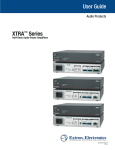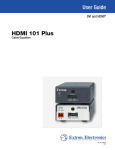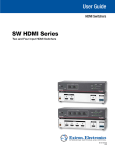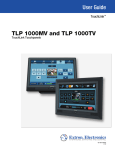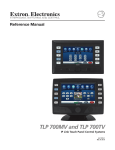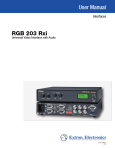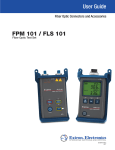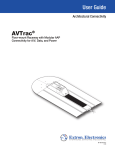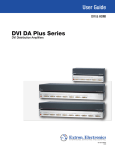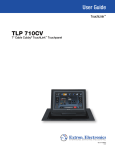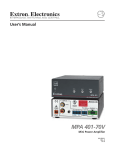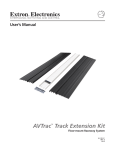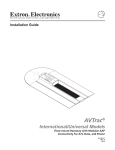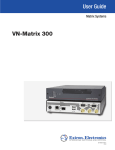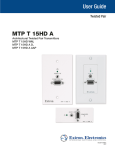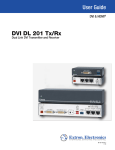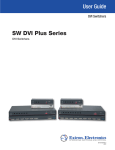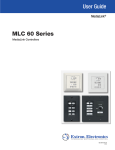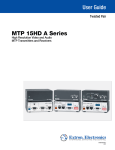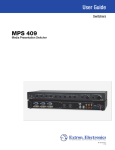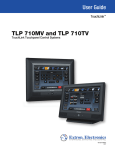Download Extron electronic DVC501SD User's Manual
Transcript
User Guide
Signal Processors
DVC 501 SD
SDI Converter
68-1518-01 Rev. A
07 11
Safety Instructions • English
This symbol is intended to alert the user of important operating and
maintenance (servicing) instructions in the literature provided with the
equipment.
This symbol is intended to alert the user of the presence of uninsulated
dangerous voltage within the product enclosure that may present a risk of
electric shock.
Warning
Power sources • This equipment should be operated only from the power source indicated on the product. This
equipment is intended to be used with a main power system with a grounded (neutral) conductor. The third
(grounding) pin is a safety feature; do not attempt to bypass or disable it.
Power disconnection • To remove power from the equipment safely, remove all power cords from the rear of
the equipment, the desktop power module (if detachable), or the power source receptacle (wall plug).
Power cord protection • Power cords should be routed so that they are not likely to be stepped on or pinched
by items placed upon or against them.
Caution
Servicing • Refer all servicing to qualified service personnel. There are no user-serviceable parts inside. To prevent
the risk of shock, do not attempt to service this equipment yourself because opening or removing covers may
expose you to dangerous voltage or other hazards.
Retain Instructions • The safety instructions should be kept for future reference.
Slots and openings • If the equipment has slots or holes in the enclosure, these are provided to prevent
overheating of sensitive components inside. These openings must never be blocked by other objects.
Read Instructions • Read and understand all safety and operating instructions before using the equipment.
Follow Warnings • Follow all warnings and instructions marked on the equipment or in the user information.
Avoid Attachments • Do not use tools or attachments that are not recommended by the equipment
manufacturer because they may be hazardous.
Consignes de Sécurité • Français
Ce symbole sert à avertir l’utilisateur que la documentation fournie avec le
matériel contient des instructions importantes concernant l’exploitation et la
maintenance (réparation).
Ce symbole sert à avertir l’utilisateur de la présence dans le boîtier
de l’appareil de tensions dangereuses non isolées posant des risques
d’électrocution.
Attention
Lire les instructions• Prendre connaissance de toutes les consignes de sécurité et d’exploitation avant
d’utiliser le matériel.
Conserver les instructions• Ranger les consignes de sécurité afin de pouvoir les consulter à l’avenir.
Respecter les avertissements • Observer tous les avertissements et consignes marqués sur le matériel ou
présentés dans la documentation utilisateur.
Eviter les pièces de fixation • Ne pas utiliser de pièces de fixation ni d’outils non recommandés par le
fabricant du matériel car cela risquerait de poser certains dangers.
Sicherheitsanleitungen • Deutsch
Lithium battery • There is a danger of explosion if battery is incorrectly replaced. Replace it only with the
same or equivalent type recommended by the manufacturer. Dispose of used batteries according to the
manufacturer instructions.
Avertissement
Alimentations • Ne faire fonctionner ce matériel qu’avec la source d’alimentation indiquée sur l’appareil. Ce
matériel doit être utilisé avec une alimentation principale comportant un fil de terre (neutre). Le troisième
contact (de mise à la terre) constitue un dispositif de sécurité : n’essayez pas de la contourner ni de la
désactiver.
Déconnexion de l’alimentation• Pour mettre le matériel hors tension sans danger, déconnectez tous les
cordons d’alimentation de l’arrière de l’appareil ou du module d’alimentation de bureau (s’il est amovible) ou
encore de la prise secteur.
Protection du cordon d’alimentation • Acheminer les cordons d’alimentation de manière à ce que personne
ne risque de marcher dessus et à ce qu’ils ne soient pas écrasés ou pincés par des objets.
Réparation-maintenance • Faire exécuter toutes les interventions de réparation-maintenance par un
technicien qualifié. Aucun des éléments internes ne peut être réparé par l’utilisateur. Afin d’éviter tout danger
d’électrocution, l’utilisateur ne doit pas essayer de procéder lui-même à ces opérations car l’ouverture ou le
retrait des couvercles risquent de l’exposer à de hautes tensions et autres dangers.
Fentes et orifices • Si le boîtier de l’appareil comporte des fentes ou des orifices, ceux-ci servent à empêcher les
composants internes sensibles de surchauffer. Ces ouvertures ne doivent jamais être bloquées par des objets.
Lithium Batterie • Il a danger d’explosion s’ll y a remplacment incorrect de la batterie. Remplacer uniquement
avec une batterie du meme type ou d’un type equivalent recommande par le constructeur. Mettre au reut les
batteries usagees conformement aux instructions du fabricant.
Vorsicht
Dieses Symbol soll dem Benutzer in der im Lieferumfang enthaltenen
Dokumentation besonders wichtige Hinweise zur Bedienung und Wartung
(Instandhaltung) geben.
Stromquellen • Dieses Gerät sollte nur über die auf dem Produkt angegebene Stromquelle betrieben werden.
Dieses Gerät wurde für eine Verwendung mit einer Hauptstromleitung mit einem geerdeten (neutralen) Leiter
konzipiert. Der dritte Kontakt ist für einen Erdanschluß, und stellt eine Sicherheitsfunktion dar. Diese sollte nicht
umgangen oder außer Betrieb gesetzt werden.
Dieses Symbol soll den Benutzer darauf aufmerksam machen, daß im Inneren
des Gehäuses dieses Produktes gefährliche Spannungen, die nicht isoliert sind
und die einen elektrischen Schock verursachen können, herrschen.
Stromunterbrechung • Um das Gerät auf sichere Weise vom Netz zu trennen, sollten Sie alle Netzkabel aus der
Rückseite des Gerätes, aus der externen Stomversorgung (falls dies möglich ist) oder aus der Wandsteckdose
ziehen.
Achtung
Lesen der Anleitungen • Bevor Sie das Gerät zum ersten Mal verwenden, sollten Sie alle Sicherheits-und
Bedienungsanleitungen genau durchlesen und verstehen.
Aufbewahren der Anleitungen • Die Hinweise zur elektrischen Sicherheit des Produktes sollten Sie
aufbewahren, damit Sie im Bedarfsfall darauf zurückgreifen können.
Befolgen der Warnhinweise • Befolgen Sie alle Warnhinweise und Anleitungen auf dem Gerät oder in der
Benutzerdokumentation.
Keine Zusatzgeräte • Verwenden Sie keine Werkzeuge oder Zusatzgeräte, die nicht ausdrücklich vom
Hersteller empfohlen wurden, da diese eine Gefahrenquelle darstellen können.
Instrucciones de seguridad • Español
Este símbolo se utiliza para advertir al usuario sobre instrucciones
importantes de operación y mantenimiento (o cambio de partes) que se
desean destacar en el contenido de la documentación suministrada con los
equipos.
Este símbolo se utiliza para advertir al usuario sobre la presencia de
elementos con voltaje peligroso sin protección aislante, que puedan
encontrarse dentro de la caja o alojamiento del producto, y que puedan
representar riesgo de electrocución.
Precaucion
Leer las instrucciones • Leer y analizar todas las instrucciones de operación y seguridad, antes de usar el
equipo.
Conservar las instrucciones • Conservar las instrucciones de seguridad para futura consulta.
Obedecer las advertencias • Todas las advertencias e instrucciones marcadas en el equipo o en la
documentación del usuario, deben ser obedecidas.
Evitar el uso de accesorios • No usar herramientas o accesorios que no sean especificamente
recomendados por el fabricante, ya que podrian implicar riesgos.
安全须知 • 中文
这个符号提示用户该设备用户手册中有重要的操作和维护说明。
这个符号警告用户该设备机壳内有暴露的危险电压,有触电危险。
注意
阅读说明书 • 用户使用该设备前必须阅读并理解所有安全和使用说明。
保存说明书 • 用户应保存安全说明书以备将来使用。
遵守警告 • 用户应遵守产品和用户指南上的所有安全和操作说明。
避免追加 • 不要使用该产品厂商没有推荐的工具或追加设备,以避免危险。
Schutz des Netzkabels • Netzkabel sollten stets so verlegt werden, daß sie nicht im Weg liegen und niemand
darauf treten kann oder Objekte darauf- oder unmittelbar dagegengestellt werden können.
Wartung • Alle Wartungsmaßnahmen sollten nur von qualifiziertem Servicepersonal durchgeführt werden.
Die internen Komponenten des Gerätes sind wartungsfrei. Zur Vermeidung eines elektrischen Schocks
versuchen Sie in keinem Fall, dieses Gerät selbst öffnen, da beim Entfernen der Abdeckungen die Gefahr eines
elektrischen Schlags und/oder andere Gefahren bestehen.
Schlitze und Öffnungen • Wenn das Gerät Schlitze oder Löcher im Gehäuse aufweist, dienen diese zur
Vermeidung einer Überhitzung der empfindlichen Teile im Inneren. Diese Öffnungen dürfen niemals von
anderen Objekten blockiert werden.
Litium-Batterie • Explosionsgefahr, falls die Batterie nicht richtig ersetzt wird. Ersetzen Sie verbrauchte Batterien
nur durch den gleichen oder einen vergleichbaren Batterietyp, der auch vom Hersteller empfohlen wird.
Entsorgen Sie verbrauchte Batterien bitte gemäß den Herstelleranweisungen.
Advertencia
Alimentación eléctrica • Este equipo debe conectarse únicamente a la fuente/tipo de alimentación eléctrica
indicada en el mismo. La alimentación eléctrica de este equipo debe provenir de un sistema de distribución
general con conductor neutro a tierra. La tercera pata (puesta a tierra) es una medida de seguridad, no
puentearia ni eliminaria.
Desconexión de alimentación eléctrica • Para desconectar con seguridad la acometida de alimentación
eléctrica al equipo, desenchufar todos los cables de alimentación en el panel trasero del equipo, o desenchufar
el módulo de alimentación (si fuera independiente), o desenchufar el cable del receptáculo de la pared.
Protección del cables de alimentación • Los cables de alimentación eléctrica se deben instalar en lugares
donde no sean pisados ni apretados por objetos que se puedan apoyar sobre ellos.
Reparaciones y mantenimiento • Solicitar siempre los servicios técnicos de personal calificado. En el interior
no hay partes a las que el usuario deba acceder. Para evitar riesgo de electrocución, no intentar personalmente
la reparación/mantenimiento de este equipo, ya que al abrir o extraer las tapas puede quedar expuesto a
voltajes peligrosos u otros riesgos.
Ranuras y aberturas • Si el equipo posee ranuras o orificios en su caja/alojamiento, es para evitar el
sobrecalientamiento de componentes internos sensibles. Estas aberturas nunca se deben obstruir con otros
objetos.
Batería de litio • Existe riesgo de explosión si esta batería se coloca en la posición incorrecta. Cambiar esta
batería únicamente con el mismo tipo (o su equivalente) recomendado por el fabricante. Desachar las baterías
usadas siguiendo las instrucciones del fabricante.
警告
电源 • 该设备只能使用产品上标明的电源。 设备必须使用有地线的供电系统供电。 第三条线(
地线)是安全设施,不能不用或跳过 。
拔掉电源 • 为安全地从设备拔掉电源,请拔掉所有设备后或桌面电源的电源线,或任何接到市电
系统的电源线。
电源线保护 • 妥善布线, 避免被踩踏,或重物挤压。
维护 • 所有维修必须由认证的维修人员进行。 设备内部没有用户可以更换的零件。为避免出现触
电危险不要自己试图打开设备盖子维修该设备。
通风孔 • 有些设备机壳上有通风槽或孔,它们是用来防止机内敏感元件过热。 不要用任何东西
挡住通风孔。
锂电池 • 不正确的更换电池会有爆炸的危险。必须使用与厂家推荐的相同或相近型号的电池。按
照生产厂的建议处理废弃电池。
ii
FCC Class A Notice
This equipment has been tested and found to comply with the limits for a Class A digital device, pursuant to part 15
of the FCC Rules. Operation is subject to the following two conditions:
1. This device may not cause harmful interference.
2. This device must accept any interference received, including interference that may cause undesired operation.
The Class A limits are designed to provide reasonable protection against harmful interference when the equipment
is operated in a commercial environment. This equipment generates, uses, and can radiate radio frequency energy
and, if not installed and used in accordance with the instruction manual, may cause harmful interference to radio
communications. Operation of this equipment in a residential area is likely to cause harmful interference, in which
case the user will be required to correct the interference at his own expense.
NOTE: This unit was tested with shielded cables on the peripheral devices. Shielded cables must be used with
the unit to ensure compliance with FCC emissions limits.
For more information on safety guidelines, regulatory compliances, EMI/EMF compliance, accessibility, and
related topics, click here.
iii
Conventions Used in this Guide
In this user guide, the following conventions are used:
NOTE: A note draws attention to important information.
TIP: A tip provides a suggestion to make working with the device easier.
CAUTION: A caution indicates a potential hazard to equipment or data.
WARNING: A warning warns of things or actions that might cause injury, death, or
other severe consequences.
Commands are written in the fonts shown here:
^AR Merge Scene,,Op1 scene 1,1 ^B 51 ^W^C
[01] R 0004 00300 00400 00800 00600 [02] 35 [17] [03]
E X! *X1&* X2)* X2#* X2! CE}
NOTE: For commands and examples of computer or device responses mentioned
in this guide, the character “0” is used for the number zero and “O”
represents the capital letter “o.”
Computer responses and directory paths that do not have variables are written in the font
shown here:
Reply from 208.132.180.48: bytes=32 times=2ms TTL=32
C:\Program Files\Extron
Variables are written in slanted form as shown here:
ping xxx.xxx.xxx.xxx —t
SOH R Data STX Command ETB ETX
Selectable items, such as menu names, menu options, buttons, tabs, and field names are
written in the font shown here:
From the File menu, select New.
Click the OK button.
Copyright
© 2011 Extron Electronics. All rights reserved.
Trademarks
All trademarks mentioned in this guide are the properties of their respective owners.
iv
Contents
Introduction............................................................ 1
Remote Configuration and Control................. 21
About this Guide................................................. 1
About the DVC 501 SD Converter....................... 1
Features............................................................... 1
Application Diagram............................................ 2
Communication Ports........................................ 21
Using SIS Commands......................................... 21
DVC-initiated Messages................................. 21
Error Responses............................................. 22
Using the Command and Response Table....... 22
Symbol Definitions......................................... 23
Command and Response Table.......................... 24
Installation............................................................... 3
Installation Overview............................................ 3
Rear Panel........................................................... 4
Connecting for Remote Control........................... 5
Connecting to the RS-232 Port........................ 5
Connecting to the USB Config Port.................. 6
Operation................................................................. 9
Front Panel.......................................................... 9
Powering On..................................................... 10
Default Cycle................................................. 10
Default Cycle — Special Conditions............... 10
Menus on the LCD Screen.................................. 11
Menu System Overview.................................. 11
Output Configuration Menu.......................... 13
Audio Config Menu....................................... 14
Advanced Config Menu................................. 15
Exiting the Menu System................................ 16
Resetting .......................................................... 16
Front Panel Lockout (Executive Mode)................ 17
Updating Firmware............................................ 17
Reference Information........................................ 26
Specifications..................................................... 26
Part Numbers and Accessories............................ 29
Included Parts................................................ 29
Optional Accessories...................................... 29
Mounting the DVC 501 SD Converter................ 29
Rack Mounting.............................................. 29
Under-desk Mounting.................................... 30
Through-desk Mounting................................ 31
DVC 501 SD • Contents
v
DVC 501 SD • Contents
vi
Introduction
This section gives an overview of the Extron DVC 501 SD Digital Video Converter. Topics
include:
•
About this Guide
•
About the DVC 501 SD Converter
•
Features
•
Application Diagram
About this Guide
This guide provides information for experienced installers on how to install, configure, and
operate the DVC 501 SD converter.
In this guide, the terms “DVC,” “DVC 501 SD,” and “converter” are used interchangeably
to refer to the DVC 501 SD converter.
About the DVC 501 SD Converter
The Extron DVC 501 SD is a digital video converter that receives SDI, HD-SDI, and 3G-SDI
serial digital video signals and converts them to DVI-D and analog RGB or component video.
It is compliant with SMPTE 259M, 292M, 424M, and ITU digital video standards. The RGB
output can be set for RGBHV, RGBS, and RGsB. Bi-level or tri-level sync can be selected when
the unit is set for component video output.
The DVC 501 SD converter is particularly suited to applications such as television production,
medical imaging, and live events that require interfacing of SDI signals from broadcast-type
sources to professional and consumer-level displays and signal distribution systems that
accept only DVI or analog signals.
Features
The DVC 501 SD provides the following features:
•
Input — Female BNC connector with buffered loop-through for multi-rate SDI signals
•
Outputs — DVI-D and 15-pin HD connectors for digital and analog RGB or component
video; a captive screw connector for balanced and unbalanced stereo audio
•
Multi-rate SDI signals up to 2.97 Gbps accepted — Accepts data rates from
standard definition NTSC and PAL to HDTV 1080p/60. It complies with SMPTE 259M,
292M, 424M, and ITU digital video standards.
•
Simultaneous DVI-D and analog RGB or component video outputs — Provides
high resolution digital and analog video outputs that allow for easy integration of
multi-rate SDI signals into DVI or RGB-based AV devices and systems.
•
AES3 audio de-embedding — Extracts and outputs embedded AES3 stereo audio
streams. Audio can be balanced or unbalanced.
•
Balanced or unbalanced audio output
•
Audio attenuation control
DVC 501 SD • Introduction
1
•
Analog RGB or component video output — Outputs analog RGB as RGBHV, RGBS,
or RGsB. Outputs component video as R-Y, B-Y, Y.
•
Buffered loop-through connector — A buffered input loop-through delivers reshaped
and restored multi-rate SDI signals.
•
Bi-level or tri-level sync is available for component video output.
•
Internal test patterns for calibration and setup — Nine test patterns are available,
including a crop pattern, color bars, and grayscale.
•
Muting control — Provides video and audio output muting.
•
RS-232 configuration and control — An RS-232 serial port provides configuration and
control via the Extron Simple Instruction Set (SIS™) commands.
•
USB configuration and control — A USB Config port provides configuration and
control via SIS commands.
•
Front panel security lockout — Locks out all front panel functions except for input
selection (all functions remain available through RS-232 or USB control).
•
Rack and furniture mountable 1U, half rack width metal enclosure
•
Internal universal power supply — The 100-240 VAC, 50-60 Hz, international power
supply provides worldwide power compatibility.
Application Diagram
The following diagram shows an example of a DVC 501 SD application.
Extron
SI 28
Surface-mount
Speakers
02
A 10
XP
T
TEC
RO
1
R
OVE P
TEM
2
R/P
ITE
LIM
NAL
SIG
Extron
XPA 1002
Power
Amplifier
DIO
AU
R
UT
L
TP
OU
,B-Y
-Y,Y
B/R
RG
N/A
-232
RS
Tx
Rx
I-D
DV
T
PU
IN
X
5A
0V
~ 0.
0-24
DI
I/
10
Extron
DVC 501 SD
MA
SD
/60
ED H
ER UG
FF RO
BU-TH
OP
LO
-S
HD
HD Projector
Hz
50
DVI
SDI/HD-SDI to DVI and
RGB/YUV Converter
RGBHV
HD-SDI
HD-SDI
Flat Panel Display
HDTV Camera
Figure 1.
Video Capture
Connection Diagram for a DVC 501 SD
DVC 501 SD • Introduction
2
Installation
This section gives an overview of the steps for installing the DVC 501 SD. It also provides a
description of the rear panel connectors and instructions for cabling. Topics include:
•
Installation Overview
•
Rear Panel
•
Connecting for Remote Control
Installation Overview
CAUTION: Installation and service must be performed by authorized personnel only.
Follow these steps to install and set up the DVC 501 SD:
1. Disconnect power from the converter and ensure that all other devices that will be
connected to it are powered off.
2. (Optional) Mount the unit in a rack or to furniture (see “Mounting the
DVC 501 SD Converter” in the “Reference Information” section).
3. Connect the input. Connect an SDI, HD-SDI, or 3G-SDI source to the 3G/HD/SD-SDI
Input BNC connector (b in figure 2 on the next page).
4. (Optional) Connect a monitor or recording device. Attach a monitor or a video
recording device to the Buffered Loop-through Input BNC connector (c in figure 2).
5. Connect the video output. Connect a display or other output device to one of the
following connectors:
•
DVD-D — Digital video (d in figure 2)
•
RGB/R-Y,Y,B-Y — Analog RGB (RGBHV, RGBS, and RGsB) or YUV component video
(e in figure 2)
6. Connect the audio output. Connect an amplifier or other audio output device to the
5-pole captive screw audio connector (f in figure 2).
7. Connect a control device. Connect a computer or control system to one of the
following DVC ports to configure and control the converter via SIS commands.
•
Config port (front panel) — USB connection (a in figure 9, “Operation”
section)
•
RS-232 port (rear panel) — Serial RS-232 connection (g in figure 2)
NOTE: See “Command and Response Table” in the “Remote Configuration
and Control” section for definitions of the SIS commands.
8. Plug a standard IEC power cord (provided) into the power receptacle (a in the diagram
on the next page). Connect the DVC to a 100 to 240 VAC, 50-60 Hz AC power source.
9. Configure the DVC 501 SD as needed, using the front panel menus (see “Menus on
the LCD Screen” in the “Operation” section) or SIS commands (see the “Remote
Configuration and Control” section).
DVC 501 SD • Installation
3
Rear Panel
The illustration below shows the connectors on the DVC 501 SD rear panel.
CAUTION: Use electrostatic discharge precautions (be electrically grounded) when
making connections. Electrostatic discharge (ESD) can damage equipment,
although you may not feel, see, or hear it.
WARNING: Remove power from the system before making any connections.
2
1
100-240V ~ 0.3A MAX
5
4
3
INPUT
6
OUTPUT
AUDIO
3G/HD/SD-SDI
BUFFERED
LOOP-THROUGH
DVI-D
RGB/R-Y,Y,B-Y
L
R
RS-232
50/60 Hz
N/A
Tx Rx
7
Figure 2.
DVC 501 SD Rear Panel
a AC power connector — Plug a standard IEC power cord into this male IEC connector
to connect the DVC to a 100 to 240 VAC, 50 Hz or 60 Hz power source.
b 3G/HD/SD-SDI connector — Connect a 3G, HD-SDI, or SD-SDI source to this female
BNC input connector.
c Buffered loop-through — This female BNC input connector passes a buffered 3G,
HD-SDI, or SD-SDI signal through to a monitor or a video storage device.
d DVI-D output connector — Connect a DVI output device to this female single-link
DVI-I connector (only the digital pins are enabled). RGB or YUV color space is available
on this buffered output. The following table shows the pin assignments for this
connector.
Pin
Signal
Pin
Signal
Pin
Signal
1
TMDS data 2–
9
TMDS data 1–
17
TMDS data 0–
2
TMDS data 2+ 10 TMDS data 1+
18
TMDS data 0+
3
Ground (2/4 )
11 Ground (1/3)
19
Ground (0/5)
4
Not used
12 Not used
20
Not used
5
Not used
13 Not used
21
Not used
6
DDC clock
14 +5 V power
22
Ground (clock)
7
DDC data
15 Ground (for 5 V) 23
TMDS clock+
8
Not used
16 Hot plug detect
TMDS clock–
Figure 3.
24
9
1
8
17
24
DVI-D Connector Pin Assignments
e RGB/YUV output connector — Connect an RGB (RGBHV, RGBS, RGsB) or YUV
component (R-Y, Y, B-Y) display device to this female 15-pin HD connector. RGB or YUV
color space is available on this buffered output.
DVC 501 SD • Installation
4
f Audio output connector — Connect an audio device to this female 5-pole 3.5 mm
captive screw connector for balanced or unbalanced analog audio output. Wire the
connector as shown below.
Figure 4.
R
R
Balanced Audio Output
Tip
Sleeves
Tip
L
L
Tip
Ring
Sleeves
Tip
Ring
Do not tin the wires!
Unbalanced Audio Output
Audio Output Connector Wiring
CAUTIONS: •
The length of the exposed wires in the stripping process is critical. The ideal length is 3/16 inches (5 mm). If the exposed portion is longer, the wires may touch, causing a short circuit between them. If the exposed wires are shorter, they can be easily pulled out, even if tightly fastened by the captive screws.
• Do not tin the wires. Tinned wire does not hold its shape and can
become loose over time.
• For unbalanced audio, connect the sleeves to the ground contact.
DO NOT connect them to negative (–) contacts.
g RS-232 connector — Connect a host device such as a computer or touch panel control
system to the Tx, Rx, and _ (ground) pins of this 5-pole captive screw connector for
serial control of the DVC by SIS commands (see “Connecting to the RS-232 Port,”
below, for information on wiring this port). The first and second pins of this connector
are not used.
The default protocol for this port is 9600 baud, 1 stop bit, no parity, and no flow
control.
Connecting for Remote Control
Connecting to the RS-232 Port
To connect your computer or control system to the DVC rear panel RS-232 port, use an
Extron Universal Control cable (UC50' or UC100'; see “Optional Accessories” in the
“Reference Information” section for part numbers) or other female 9-pin-to-bare-wire
RS-232 cable.
1. Wire the unterminated end of the RS-232 cable to the 3-pole captive screw connector,
provided with the DVC, as follows:
a. Connect the transmit wire to the middle pin, which plugs into the Tx (transmit) port.
b. Connect the receive wire to the fourth pin, which plugs into the Rx (receive) port.
c. Connect the ground wire to the last pin, which plugs into the ground port, marked
with _.
2. Plug the cable into the RS-232 portion of the 5-pole captive screw connector on the
DVC rear panel.
See the illustration on the next page.
DVC 501 SD • Installation
5
RS-232
N/A Tx Rx
1 2 3
DVC 501 SD or
Rear Panel
RS-232 Port
NOTE: Connect a ground wire between the DVC
and the computer or control system.
Ground ( )
Receive (Rx)
Transmit (Tx)
Transmit (Tx)
Receive (Rx)
NOTE: If you use cable that has a drain
wire, tie the drain wire to ground
at both ends.
Figure 5.
Computer or
Control System
RS-232 Port
Connecting to the RS-232 Port
In the “Remote Configuration and Control” section, see “Using SIS Commands” for
information on sending SIS commands to this port.
Connecting to the USB Config Port
The mini Type B USB Config port is located on the DVC front panel. It can be used to
configure the converter via SIS commands.
1. Use a USB A-to-mini-B cable to connect the DVC USB Config port to a USB port on your
computer.
Mini Type B
USB
Type A
USB
USB 1
USB
Ports
USB Cable
MENU
ADJUST
NEXT
CONFIG
Extron
DVC SERIES
DIGITAL VIDEO CONVERTER
Computer
Converter Front Panel
Figure 6.
Connecting to the Config Port
DVC 501 SD • Installation
6
2. If this is the first time you have connected a DVC 501 SD to this particular USB port on
your computer, the Found New Hardware Wizard opens. On the first screen, specify
whether you want the computer to connect to Windows® Update in order to search the
web for the driver that it needs to communicate with the DVC via the USB port (this is
not necessary if the USB driver already exists on your computer).
Figure 7.
Found New Hardware Wizard Opening Screen
•
Select the Yes, this time only radio button if you want your computer to
connect to Windows Update only this one time.
•
Select Yes, now and every time I connect a device if you want the computer to
automatically connect to Windows Update every time the DVC is connected to this
USB port.
•
Select No, not this time if you do not want the computer to connect to Windows
Update at this time (for example, if the driver is already on your computer).
DVC 501 SD • Installation
7
3. Click Next. On the next screen, make sure that the Install the software
automatically (Recommended) radio button is selected, then click Next (you do not
need to insert a disc).
Figure 8.
Selecting the Radio Button to Install the USB Driver Automatically
Your computer locates the driver needed for it to communicate with the DVC 501 SD via
the USB port.
4. When the Completed screen appears, click Finish to close the wizard.
NOTE: This wizard appears only the first time you connect the DVC to each USB
port. You do not see the wizard again unless you connect the DVC to a
different USB port on your computer.
5. Configure the DVC as desired, using SIS commands (see the “Using SIS Commands”
section for more information).
DVC 501 SD • Installation
8
Operation
This section discusses the functions available through the front panel to set up and operate
the DVC 501 SD. Topics include:
•
Front Panel
•
Powering On
•
Menus on the LCD Screen
•
Resetting
•
Front Panel Lockout (Executive Mode)
•
Updating Firmware
Front Panel
1
2
3
MENU
4
5
ADJUST
NEXT
CONFIG
DVC 501 SD
DIGITAL VIDEO CONVERTER
Figure 9.
DVC 501 SD Front Panel
The front panel features and controls shown in the illustration above are described starting
below.
a Config port — Connect a USB cable (USB A-to-mini-B) from your computer to this port
to configure and control the DVC via SIS commands and to update the firmware.
b LCD screen — Displays menus, messages, and your selections from menus and
submenus (see “Menus on the LCD Screen,” later in this section, for more
information).
c Menu button — Press this button to access the DVC menu system and step through
the menus displayed on the LCD screen (b) (see “Menus on the LCD Screen” for
details).
d Next button — Press this button to step through the submenus displayed on the LCD
screen.
e Adjust knobs — Rotate these horizontal ([) and vertical ({) knobs to scroll through
submenu options and make adjustments.
DVC 501 SD • Operation
9
Powering On
Apply power by connecting the provided IEC power cord to the rear panel power connector
on the DVC. Connect the DVC to an AC power source.
NOTE: Audio and video mute settings are not retained when power is cycled to the
DVC.
Default Cycle
When power is applied, the LCD screen displays the Extron S3 logo. After approximately
10 seconds, EXTRON DVC 501 SD is displayed. The unit part number and current firmware
version are displayed after approximately another 5 seconds. After those screens, the default
cycle begins, in which the LCD screen alternates every 5 seconds between the input signal
type and data rate, and the output resolution and refresh rate. The default cycle continues
while the menu system is not in use.
The flow diagram below shows the order in which the screens appear at power-up and
during the default cycle.
10 sec.
Power
On
EXTRON
DVC 501 SD
5 sec.
60-1033-01
F/W V1.00
5 sec.
INPUT
HDSDI 1.485G
5 sec.
INPUT
720p @59.94Hz
5 sec.
Figure 10. Power-up and Normal Default Cycle Example
Default Cycle — Special Conditions
The default cycle changes when any of the following conditions exist:
•
No input connected — A single screen is displayed, indicating that there is no input
signal.
INPUT
NO SIGNAL!
Figure 11. Default Screen When No Input Is Connected
DVC 501 SD • Operation
10
•
Overheating — The Temperature Overload!!! screen is added to the default cycle if
the internal temperature of the unit exceeds 65 °C (149 °F).
INPUT
HDSDI 1.485G
5 sec.
INPUT
720p @59.94Hz
5 sec.
TEMPERATURE
OVERLOAD!!!
5 sec.
Figure 12. Example of the Default Cycle When the Unit Is Overheating
•
Video muted — The input resolution and rate screen (second screen of the default
cycle) displays a blinking asterisk (*) on both sides of the word INPUT. The asterisks
disappear when the video is unmuted (the asterisks also appear on the INPUT NO
SIGNAL! screen during video muting.)
INPUT
HDSDI 1.485G
5 sec.
* INPUT *
720p @59.94Hz
5 sec.
Figure 13. Example of the Default Cycle When the Video Is Muted
To mute and unmute the video, see the Video Mute SIS commands in the “Remote
Configuration and Control” section.
Menus on the LCD Screen
The DVC 501 SD menus that are displayed on the LCD screen enable you to configure
and operate the converter. The menu navigation buttons (Menu and Next) are located to
the right of the LCD screen. Press these buttons to cycle through the available menus and
submenus, and use the horizontal and vertical Adjust knobs to select options.
This section provides information on the menus and submenus, including any procedures
that are initiated from them.
Menu System Overview
The menu system consists of three menus, which have submenus that enable you to make
desired adjustments (see the menu flow diagram on the next page).
Using the menus
1. To access the menu system, press the Menu button. The first menu (OUTPUT CONFIG) is
displayed on the LCD screen.
2. Select other menus by repeatedly pressing the Menu button until the desired menu is
displayed.
3. Press the Next button repeatedly to cycle through the submenus for the selected menu.
4. When the desired submenu is displayed, rotate the horizontal ([) or vertical ({) Adjust
knob clockwise or counterclockwise to cycle through the submenu options. If you want
to return to a menu from within one of its submenus, press Menu.
5. When the desired option is displayed, do one of the following to select it:
•
Press Next to display another submenu.
•
Press Menu repeatedly until the EXIT MENU PRESS NEXT screen appears, then press
the Next button to return to the default cycle.
•
Wait until the LCD screen returns to the default cycle (approximately 30 seconds).
DVC 501 SD • Operation
11
NOTE: The menus time out and the default cycle is displayed after 30 seconds of
inactivity; however, any selections you made with the Adjust knobs are saved
and remain in effect until you change them or reset the unit to factory defaults
(see “Resetting,” later in this section).
Menu flow diagram
The flow diagram below shows the menus that are displayed in the front panel LCD screen
and the order in which they appear when you repeatedly press the Menu button.
Default
Cycle
Menu
OUTPUT
CONFIG
30 sec.
Menu
AUDIO
CONFIG
30 sec.
Menu
ADVANCED
CONFIG
30 sec.
Menu
Menu
EXIT MENU
PRESS NEXT
30 sec.
Next
Figure 14. Main Menu Flow Diagram
DVC 501 SD • Operation
12
Output Configuration Menu
The output configuration menu allows you to set the output resolution and refresh rate, the
output signal type, and the sync polarity (RGBHV only). The following flow diagram shows
the output configuration submenus and the adjustments that can be made from them.
Default
Cycle
*This screen appears only if
RGBHV is selected for the format.
Menu
OUTPUT
CONFIG
FORMAT
RGBHV
Next
H
POS
Next
SYNC
V
POS
Use either Adjust knob to
select a submenu option.
Select the signal format:
• RGBHV (default)
• RGBS
• RGsB
• YUV Bi-Level
• YUV Trilevel
Select the sync polarity
combination (Horizontal
and Vertical):*
• Neg
Neg
• Neg
Pos
• Pos
Neg
• Pos
Pos (default)
Next
Figure 15. Output Configuration Menu
The output format and sync polarity can be configured for both the analog and DVI
outputs. The color space affects both outputs, and the sync polarity is transmitted in the DVI
information frame for the display to interpret if necessary.
Format submenu
Rotate either the horizontal ([) or the vertical ({) Adjust knob to select the output video
format required by the display. Available signal types are RGBHV (default), RGBS, RGsB,
YUV bi-level, and YUV tri-level.
NOTE: Setting the sync format to YUV bi-level and tri-level also affects the colorspace of the
DVI output.
Sync Polarity submenu
The display device may require a particular combination of horizontal (H) and vertical (V) sync
signal polarities. Select the appropriate combination of positive or negative H and V sync by
rotating either the horizontal ([) or vertical ({) Adjust knob. Options are H-V-, H+V-, H-V+,
or H+V+ (default).
Resolutions and refresh rates
The output resolution and refresh rate follow those of the source device. The table below
shows the resolutions and refresh rates on the DVC 501 SD.
Resolution/
Rate
23.98 Hz 24 Hz
720p
25 Hz
X
29.97 Hz 30 Hz 50 Hz 59.94 Hz 60 Hz
X
X
1080i
1080p
X
X
X
X
X
X
X
X
X
X
X
X
X
X
NTSC
PAL
X
X
DVC 501 SD • Operation
13
Audio Config Menu
The Audio Config menu enables you to adjust the level of attenuation, mute and unmute
the audio, and select the pair of audio channels on which to extract the audio from the
3G-SDI, HD-SDI, or SD-SDI signal. The flow diagram below shows the audio configuration
submenus and the adjustments that can be made from them.
OUTPUT
CONFIG
Menu
AUDIO
CONFIG
AUDIO MUTE
DISABLED
Next
Next
GAIN/ATTEN
0 dB
Turn either Adjust knob
to select a setting.
Mute or unmute the audio.
• DISABLED (Default)
• ENABLED
Set the audio attenuation
for the selected input.
• Range: -18 through 0 dB
• Default: 0
Next
DECODE AUDIO
ON PAIR <1>
Select an audio pair to
extract.
• Range: 1 through 8
• Default: 1
Figure 16. Audio Config Menu
Audio Mute submenu
From this submenu you can mute or unmute the audio. Rotate either Adjust knob to select
Enabled to mute the audio or Disabled to unmute it.
Gain/Atten submenu
You can set only the attenuation level from this submenu. To set the attenuation,
rotate either Adjust knob to the right to decrease the attenuation and to the left to
increase it (-18 through 0 dB). The default is 0 dB.
Decode Audio on Pair <N> submenu
On this screen, you can select the channel pair on which the embedded audio will be
extracted and output onto the 5-pole captive screw audio connector. Rotate either Adjust
knob until the desired channel pair number (1 through 8) is displayed within the angle
brackets.
DECODE AUDIO
ON PAIR <1>
Figure 17. Example of a Decode Audio on Pair <N> LCD Submenu
DVC 501 SD • Operation
14
Advanced Config Menu
The Advanced Config menu enables you to select a test pattern and to view the internal
temperature of the unit. The flow diagram below shows the advanced configuration menu
and submenus and the adjustments that can be made from them.
AUDIO
CONFIG
Menu
ADVANCED
CONFIG
TEST PATTERN
OFF
Next
Next
INT. TEMP
91F
33C
Use either Adjust knob to
select a submenu option.
Select a test pattern:
• OFF (default)
•
• COLOR BARS
•
• GRAYSCALE
•
• X-HATCH 4x4
•
• ALT. PIXELS
•
CROP
1.33 ASPECT
1.78 ASPECT
1.85 ASPECT
2.35 ASPECT
View the internal temperature
of the unit:
Current internal temperature
expressed in degrees
Fahrenheit and Celsius (not
adjustable)
Next
Figure 18. Advanced Configuration Menu
Test Pattern submenu
The following test pattern selections are available via this submenu to help you adjust the
color, convergence, focus, resolution, contrast, grayscale, and aspect ratio of the display
device:
•
OFF (default)
•
CROP
•
COLOR BARS
•
1.33 ASPECT
•
GRAYSCALE
•
1.78 ASPECT
•
X-HATCH 4x4
•
1.85 ASPECT
•
ALT. PIXELS
•
2.35 ASPECT
To select a test pattern:
1. From the Advanced Configuration menu, press Next until the Test Pattern submenu is
displayed.
2. Rotate either Adjust knob to select a test pattern. The default is Off (no test pattern).
NOTES: • Alt. Pixels is used to calibrate the input sampling of the display devices to the
DVC output. Use this pattern to adjust the clocking and phasing of the display
until no more vertical bands are visible.
• Crop is used to center the DVC output on the display device. Adjust the
horizontal and vertical position on the display until all four crop lines are
visible.
• Grayscale is used to adjust the brightness and contrast on the display.
The illustration on the next page shows the test patterns that are available on the DVC.
NOTE: Test patterns are available only if an input device is connected to the Input
connector and a valid input signal is present.
DVC 501 SD • Operation
15
Color Bars
Crop
Grayscale
1.33 Aspect
X-Hatch 4x4
1.78 Aspect
Alt Pixels
1.85 Aspect
2.35 Aspect
Figure 19. DVC 501 SD Test Patterns
Int. Temp. screen
The Int. Temp. screen shows the current internal temperature of the DVC unit in degrees
Fahrenheit and Celsius. This is an information-only screen; no adjustments can be made
from it.
Exiting the Menu System
To exit the menu system, press the Menu button repeatedly until the EXIT MENU PRESS NEXT
screen appears. Press the Next button to return to the default cycle.
Alternatively, wait until the menu system times out and the default cycle resumes
(approximately 30 seconds).
Resetting
You can perform the following types of reset on the DVC 501 SD:
•
Firmware and settings: To reset the DVC to its factory-installed firmware version, press
the front panel Menu button while connecting power to the unit. Perform this reset if
compatibility issues arise with an updated firmware version.
•
Settings only: To reset the unit to factory default settings, press and hold the Next
button while applying power to the unit. While the reset is in progress, the LCD screen
displays SYSTEM RESET. When the reset is complete, the LCD screen displays EXTRON
DVC 501, and the default cycle starts.
-orEnter the ZXXX SIS command (see the Resetting command in the “Remote
Configuration and Control” section).
DVC 501 SD • Operation
16
Front Panel Lockout (Executive Mode)
To prevent accidental changes to settings, you can lock the DVC 501 SD front panel controls
by placing the converter in lock (executive) mode. While the DVC is in lock mode, RS-232
communication remains available, as well as the ability to exit lock mode.
•
To enable lock mode, press and hold the Menu and Next buttons simultaneously until
EXE MODE ENABLED appears in the LCD window (approximately 2 seconds).
•
To disable lock mode, press and hold the Menu and Next buttons until EXE MODE
DISABLED appears in the LCD window (approximately 2 seconds).
Lock mode also can be enabled and disabled via SIS commands (see the Front panel
security lockout (executive mode) commands in the “Remote Configuration and
Control” section).
Updating Firmware
The Firmware Loader utility enables you to update the DVC 501 SD firmware. In addition
to being provided on the Extron Software DVD, Firmware Loader is available free of charge
from the Extron website.
NOTE: For further information on using the Firmware Loader, select Help from the
Help menu on the Firmware Loader window or press the <F1> key.
To update the firmware using Firmware Loader:
1. If necessary, download the Firmware Loader software from the Extron website
(www.extron.com):
a. On the Extron web page, select the Download tab.
b. On the Download Center page, select the Software link on the left sidebar menu.
c. Locate the Firmware Loader software and click the Download link at the far right.
d. Follow the on-screen instructions to download the Firmware Loader program to
your computer.
2. From the Extron website, download the latest firmware file and install it on your
computer.
a. On the Extron web page, select the Download tab.
b. On the Download Center page, click the Firmware link on the left sidebar menu.
c. Locate the DVC 501 SD firmware and click the Download link at right.
d. On the next screen, fill in the required information, then click the Download
DVC501SD_firmware version.exe button.
e. On the next two File Download - Security Warning windows, click Run.
If you want to save the firmware installer file to install the firmware on your
computer later, click Save on these two windows. On the Save As window that
opens, browse to the folder where you want to save the firmware installation file,
and click Save. When you are ready to install the firmware on your computer, locate
and double-click this installer file.
f. Follow the instructions on the installation wizard screens to install the firmware on
your computer.
3. From the Start menu on your computer, select
All Programs>Extron Electronics>Firmware Loader>Firmware Loader.
The Firmware Loader window opens with the Add Device window in front of it.
DVC 501 SD • Operation
17
4. On the Add Device window, select DVC 501 SD from the Device Name drop-down
menu.
Figure 20. Device Name Drop-down Menu on the Add Device Window
5. From the Connection Method drop-down menu, select RS-232 or USB.
6. If using RS-232, select the appropriate options from the Com Port and Baud Rate
menus (this information is provided by your system administrator).
7. Click Connect. If the connection is successful, DVC 501 SD is displayed in green and
followed by a check mark in the Connected Device section.
8. Click the Browse button in the New Firmware File (Optional) section.
9. On the Open window, navigate to the new firmware file, which has an .s19 extension,
and double-click it. The Open window closes.
Figure 21. Open Window for the Firmware Loader
CAUTION: Valid firmware files must have the file extension .s19. A file with any
other extension is not a firmware upgrade for this product and could
cause the DVC to stop functioning.
DVC 501 SD • Operation
18
NOTES: • The original factory-installed firmware is permanently available on the
DVC 501 SD. If the attempted firmware upload fails for any reason, the
converter reverts to the factory-installed firmware.
•When downloaded from the Extron website, by default the firmware is
placed in a folder at C:\Program Files\Extron\Firmware\DVC 501 SD
or
C:\Program Files (x86)\Extron\Firmware\DVC 501 SD (for
Windows 7).
10.On the Add Device window, the path to the new firmware file is displayed in the Path
field.
11.Click Add. The Add Device window closes, and the DVC 501 SD name and information
appear in the Devices section.
Figure 22. Firmware Loader Window with a DVC 501 SD Device Added
DVC 501 SD • Operation
19
12.Click Begin. The following indicators on the Firmware Loader window show the
progress of the update:
•
The Transfer Time section shows the amount of remaining and elapsed time for the
update.
•
The Total Progress section displays a status bar with Uploading... above it.
•
In the Devices section, the Progress column displays an incrementing percentage
and the Status column displays Uploading.
The LCD screen on the DVC front panel displays FW. UPLOAD PLEASE WAIT.
Figure 23. Firmware Upload in Progress
When the upload is complete, the Remaining Time field in the Transfer Time section
shows 00:00:00, the Progress column shows 100%, and Completed is displayed above
the progress bar and in the Status column.
Figure 24. Firmware Upload Complete
The LCD screen briefly displays the Extron S3 logo, then returns to the default cycle.
13.When the firmware upload and unit reset are complete, close the Firmware Loader
window.
DVC 501 SD • Operation
20
Remote
Configuration and
Control
This section describes the connections through which the DVC 501 SD can be configured
and controlled remotely via SIS commands, and describes the commands that are available.
Topics include:
•
Communication Ports
•
Using SIS Commands
•
Command and Response Table
Communication Ports
The DVC 501 SD can be remotely controlled via a host computer or other device (such as
a control system) that is connected to the rear panel RS-232 port or the front panel USB
Config port. With an RS-232 or USB connection, you can configure and control the DVC
using SIS commands.
The protocol for the rear panel RS-232 port is 9600 baud, 1 stop bit, no parity, and no flow
control. See “Connecting to the RS-232 Port” in the “Installation” section for information
on wiring to this connector.
See “Connecting to the USB Config Port” for information on making a USB connection.
Using SIS Commands
SIS commands consist of one or more characters per command field. They do not require
any special characters to begin or end the command character sequence. When the DVC
determines that a command is valid, it executes the command and sends a response to the
host device. Each converter response to an SIS command ends with a carriage return and a
line feed (CR/LF = ]), which signals the end of the response character string. A string is one
or more characters.
DVC-initiated Messages
When a local event (such as a front panel selection) takes place, the converter responds by
sending a message to the host. No response is required from the host.
The following converter-initiated message is displayed:
© COPYRIGHT 2011, EXTRON ELECTRONICS DVC 501 SD, Vn.nn, 60-1033-01 ]
The DVC sends the copyright message when powering up while connected to the computer.
Vn.nn is the firmware version number.
DVC 501 SD • Remote Configuration and Control
21
Error Responses
When the DVC receives a valid command, it executes the command and sends a response
to the host device. If the unit is unable to execute the command because the command
contains invalid parameters, it returns an error response to the host. The responses include:
•
E10 — Invalid command
•
E13 — Invalid parameter
•
E14 — Not valid for this configuration
•
E17 — Invalid command for signal type
Using the Command and Response Table
The Command and Response Table for SIS commands, later in this section, lists the
commands that the DVC 501 SD converter recognizes as valid, the responses that are
returned to the host, a description of the command function or the results of executing the
command, and command examples.
NOTE: If the unit does not support or recognize a command that is entered, no action is
taken and no response is returned.
Space
ASCII to Hex Conversion Table
•
Figure 25. ASCII to Hexadecimal Character Conversion Table
NOTE: Upper- and lowercase text can be used interchangeably except where noted.
DVC 501 SD • Remote Configuration and Control
22
Symbol Definitions
•
=
] =
} =
E =
|
=
W =
Space
Carriage return with line feed
Carriage return with no line feed
Escape
Pipe (vertical bar) character. Has the same function as ].
Has the same function as E.
X! = On or off; enable or disable
X@ =
X# =
X$ =
X% =
X^ =
Input standard Internal temperature (in degrees
Celsius)
Test pattern
Output polarity
Output sync format
X& = SDI audio channels (AES X* =
stereo pairs)
Audio attenuation level 0 =
1 =
— =
0 =
1 =
2 =
3 =
4 =
5 =
6 =
Off or disable
On or enable
Signal not supported
No signal
NTSC
PAL
720p
1080i
1080p HD-SDI
1080p 3G SDI
0 = Off (default)
1 = Color Bars
2 = Grayscale
3 = 4x4 Crosshatch
4 = Alternating Pixels
5 = Crop
6 = 1.33 Aspect Ratio Crop
7 = 1.78 Aspect Ratio Crop
8 = 1.85 Aspect Ratio Crop
9 = 2.35 Aspect Ratio Crop
0 = H– V–
1 = H– V+
2 = H+ V–
3 = H+ V+ (default)
0 = RGBHV (default)
1 = RGBS
2 = RGsB
3 = YUV bi-level
4 = YUV tri-level
1 through 8
0 through -18 dB (-5dB = 5)
DVC 501 SD • Remote Configuration and Control
23
Command and Response Table
ASCII Command
Response
(Host to Converter)
(Converter to Host)
Mute video
1B
Vmt1 ]
Mute (blank) the video output.
Unmute video
0B
Vmt0 ]
Display the output.
View mute status
B
X! ]
Show video mute status X!. For X!:
0 = mute off, 1 = mute on.
Command
Additional Description
Video Mute
Output Configuration
Output Sync Polarity
Set polarity
E X% OPOL }
Opol X% ]
Set the sync polarity for the VGA output
to X%. For X%:
0 = H– V–
1 = H– V+
2 = H+ V–
3 = H+ V+ (default)
View polarity
E OPOL }
X% ]
View the current output sync polarity.
E X^ OSYN }
Osyn X^ ]
Set the sync format for the VGA output
to X^. For X^:
0 = RGBHV (default)
1 = RGBS
2 = RGsB
3 = YUV bi-level
4 = YUV tri-level
Output Sync Format
Set sync format
NOTE: Setting the sync format to YUV bi-level and tri-level also affects the colorspace of the DVI output.
E OSYN }
X^ ]
View the current output sync format.
Select channel
E X& AESC }
AESC X& ]
Select channel pair X& on which audio
will be decoded. X& = 1 – 8.
View channel
E AESC }
X& ]
View the channel pair to be decoded.
Enable mute
1Z
Amt1 ]
Mute the audio output.
Disable mute
0Z
Amt0 ]
Unmute the audio output.
View mute status
Z
X! ]
Show audio mute status X!. For X!:
0 = mute off, 1 = mute on.
X* g
Aud X* ]
Set audio attenuation level to X* dB.
X* = 0 through –18.
15g
Aud–15 ]
Set the audio attenuation to –15 dB.
Increment attenuation
+g
Aud X* ]
Increase the attenuation level by +1 dB.
Decrement attenuation
–g
Aud X* ]
Decrease the attenuation level by –1 dB.
View attenuation
g
X* ]
View the current audio attenuation
level.
View sync format
Audio Commands
AES Audio Channel
Audio mute
Audio attenuation (per input)
Set audio attenuation
Example
DVC 501 SD • Remote Configuration and Control
24
Command
ASCII Command
Response
(Host to Converter)
(Converter to Host)
Additional Description
Advanced Configuration
Test pattern
Select a test pattern
E X$ TEST }
Test X$ ]
Select test pattern X$. For X$:
0 = Off (default)
1 = Color Bars
2 = Grayscale
3 = 4x4 Crosshatch
4 = Alternating Pixels
5 = Crop
6 = 1.33 Aspect Ratio Crop
7 = 1.78 Aspect Ratio Crop
8 = 1.85 Aspect Ratio Crop
9 = 2.35 Aspect Ratio Crop
Turn off test patterns
E 0TEST }
Test0 ]
Disable the test pattern.
View test pattern
E TEST }
X$ ]
View the current test pattern.
Front panel security lockout (executive mode)
Enable lock mode
1X
Exe1 ]
Lock all front panel functions.
Disable lock mode
0X
Exe0 ]
Allow all front panel selections.
View lock mode status
X
X! ]
Show current lock mode status X!.
For X!:
1 = front panel locked
0 = front panel controls accessible
E ZXXX }
Zpx ]
Reset all settings and adjustments to the
factory default settings. User settings
are removed.
Resetting
Reset all settings to
factory defaults
Information Requests
General information
I
Vmt X! • Std X@ • Amt X! • Aesc X& ]
View the following device information:
Vmt = Video mute status
Std = Video standard
Amt = Audio mute status
Aesc = Channel pair selected for audio
extraction
Query firmware version
Q
n.nn ]
View the current firmware version.
Query firmware build
*Q
n.nn.nnnn
View the firmware version and build
number.
Query part number
N
60-1033-01 ]
View the unit part number.
View internal temp.
E 20STAT }
X# ]
View internal temperature X# in degrees
Celsius.
DVC 501 SD • Remote Configuration and Control
25
Reference
Information
This section provides reference information on the DVC 501 SD. The following topics are
covered:
•
Specifications
•
Part Numbers and Accessories
•
Mounting the DVC 501 SD Converter
Specifications
Video
Signal type������������������������������������� SDI, HD-SDI, and 3G-SDI digital video signals
Data rates�������������������������������������� 270 Mbps, 1.485 Gbps, 2.970 Gbps
Operation standards����������������������� SMPTE 259M-C, SMPTE 292M, SMPTE 424M
Auto data rate lock������������������������ Yes
Video input and loop through
Number/signal type������������������������ 1 SDI (SMPTE 259M-C, 270 Mbps), HD-SDI (SMPTE 292M, 1.485 Gbps), or 3G-SDI
(SMPTE 424M, 2.97 Gbps) digital component video
Connectors������������������������������������ 1 female BNC, 1 female BNC loop-through
Data rates�������������������������������������� 270 Mbps to 2.97 Gbps
Nominal level��������������������������������� 0.8 Vp-p
Impedance������������������������������������� 75 ohms
Horizontal frequency���������������������� 15 kHz to 100 kHz
Vertical frequency��������������������������� 24 Hz to 60 Hz
Resolution range���������������������������� NTSC, PAL, 720p, 1080i, 1080p
Return loss������������������������������������� <-15 dB @ 1 MHz to 1.5 GHz
DC offset (max. allowable)������������� 5 V
Input cable equalization����������������� Automatic for up to -30 dB of cable loss
HD-SDI������������������������������������ 120 m (400') using Extron RG6 cable
90 m (300') using Extron RG59 cable
SDI������������������������������������������ 150 m (500') using Extron RG6 cable
120 m (400') using Extron RG59 cable
NOTE: The transmission distance varies depending on the signal resolution and on the type of cable, graphics card,
and display used in the system.
Video processing
Digital sampling����������������������������� 24 bit, 8 bits per color, 165 MHz standard
Colors�������������������������������������������� 16.78 million
DVC 501 SD • Reference Information
26
Video output
Number/signal type������������������������ 1 single link DVI-D
1 RGB, YUV / YPbPr
Connectors������������������������������������ 1 female DVI-I
1 female 15-pin HD
Nominal level
TMDS�������������������������������������� 1.0 Vp-p swing
Analog������������������������������������ 1 Vp-p for Y of component video
0.7 Vp-p for RGB and for R-Y and B-Y of component video
Impedance
TMDS�������������������������������������� 100 ohms
RGB����������������������������������������� 75 ohms
Return loss������������������������������������� <-25 dB @ 100 MHz
DC offset��������������������������������������� ±5 mV with input at 0 offset
Sync
Output type����������������������������������� RGBHV, RGBS, RGsB, component video (bi-level or tri-level)
Output level����������������������������������� 5.0 Vp-p for RGB
0.6 Vp-p for component video tri-level sync
0.3 Vp-p for component video bi-level sync
Output impedance������������������������� 75 ohms
Output polarity������������������������������� Positive or negative (selectable)
Audio
Frequency response������������������������ 20 Hz to 20 kHz, ±0.2 dB
THD + Noise����������������������������������� 0.05% @ 1 kHz at nominal level, 0 dB gain
S/N������������������������������������������������� >100 dB at maximum output (unweighted)
Stereo channel separation�������������� >80 dB @ 1 kHz
Audio input
Number/signal type������������������������ 1 SDI embedded audio (SMPTE 272M, SMPTE 299M)
Connector�������������������������������������� 1 female BNC
Adjustment range�������������������������� -18 dB to 0 dB
Audio output
Number/signal type������������������������ 1 stereo, balanced/unbalanced
Connectors������������������������������������ (1) 3.5 mm captive screw connector, 5 pole
Impedance������������������������������������� 50 ohms unbalanced, 100 ohms balanced
Gain error�������������������������������������� ±0.1 dB channel to channel
Maximum level (Hi-Z)���������������������� +21 dBu, balanced, or +15 dBu, unbalanced, at 0.05% THD+N
Control/remote
Serial control port��������������������������� 1 RS-232, 3.5 mm captive screw connector, 5 pole (uses 3 poles)
Baud rate and protocol������������������� 9600 baud, 8 data bits, 1 stop bit, no parity
Serial control pin configuration������� 3 = Tx, 4 = Rx, 5 = GND
USB control ports��������������������������� 1 front panel female mini USB type B
USB standards�������������������������������� USB 2.0, low speed
Program control����������������������������� Extron Simple Instruction Set (SIS)
DVC 501 SD • Reference Information
27
General
Power supply���������������������������������� Internal
Input: 100 VAC to 240 VAC, 50-60 Hz
Power consumption����������������������� 12 watts
Temperature/humidity�������������������� Storage: -40 to +158 °F (-40 to +70 °C) / 10% to 90%, noncondensing
Operating: +32 to +122 °F (0 to +50 °C) / 10% to 90%, noncondensing
Cooling������������������������������������������ Convection, sides to top
Thermal dissipation������������������������ 24 BTU/hr
Mounting
Rack mount����������������������������� Yes, with optional 1U rack shelf
Furniture mount���������������������� Yes, with optional through-desk mounting kit or under-desk mounting kit
Enclosure type�������������������������������� Metal
Enclosure dimensions��������������������� 1.75" H x 8.75" W x 9.5" D (half rack wide)
4.4 cm H x 22.2 cm W x 24.1 cm D
(Depth excludes connectors and knobs.)
Product weight������������������������������� 2.3 lbs (1.1 kg)
Shipping weight����������������������������� 6 lbs (3 kg)
Vibration���������������������������������������� ISTA 1A in carton (International Safe Transit Association)
Regulatory compliance
Safety�������������������������������������� CE, c-UL, UL
EMI/EMC��������������������������������� CE, C-tick, FCC Class A, ICES, VCCI
MTBF��������������������������������������������� 30,000 hours
Warranty���������������������������������������� 3 years parts and labor
NOTES:• All nominal levels are at ±10%.
• Specifications are subject to change without notice.
DVC 501 SD • Reference Information
28
Part Numbers and Accessories
Included Parts
Description
Part Number
DVC 501 SD
60-1033-01
Rubber feet (not attached) (4)
IEC power cord (1)
5-pole captive screw connectors (2)
DVC 501 SD Setup Guide
Optional Accessories
These items can be ordered separately:
Description
Part Number
RSU Universal Rack Shelf Kit
60-190-01
RSB Basic Rack Shelf
60-604-02
MBU 125 Under-desk Mounting Kit
70-077-01
MBD 129 Through-desk Mounting Kit
70-077-02
UC50' Universal Projector Control cable, 50' (15.2 m)
26-518-01
UC100' Universal Projector Control cable, 100' (30.4 m)
26-518-02
Mounting the DVC 501 SD Converter
Rack Mounting
UL guidelines for rack mounting
The following Underwriters Laboratories (UL) guidelines pertain to the installation of the
DVC 501 SD in a rack:
•
Elevated operating ambient temperature — If the equipment is installed in a closed
or multi-unit rack assembly, the operating ambient temperature of the rack environment
may be greater than room ambient temperature. Therefore, consider installing the
equipment in an environment compatible with the maximum ambient temperature
(TMA) specified by the manufacturer.
•
Reduced air flow — Install the equipment in the rack so that the amount of air flow
required for safe operation of the equipment is not compromised.
•
Mechanical loading — Mount the equipment in the rack so that uneven mechanical
loading does not create a hazardous condition.
•
Circuit overloading — When connecting the equipment to the supply circuit, consider
the effect that circuit overloading might have on overcurrent protection and supply
wiring. Consider equipment nameplate ratings when addressing this concern.
•
Reliable earthing (grounding) — Maintain reliable grounding of rack-mounted
equipment. Pay particular attention to supply connections other than direct connections
to the branch circuit (such as the use of power strips).
DVC 501 SD • Reference Information
29
Rack mounting procedure
To rack mount the converter, you can use one of the Extron 19 inch rack shelf mounting
options (see “Optional Accessories,” earlier in this section, for part numbers).
Half-rack
false front panel
uses 2 front holes.
DIG
ITA
L
DV
C
VID
EO
(2) 4-40 x 3/16" screws
Use 2 mounting holes on
opposite corners.
50
CO
1S
NVE
D
RTE
R
Figure 27. Rack Mounting the DVC 501 SD
1. If rubber feet have been installed on the bottom of the unit, remove them.
2. Mount the DVC on the rack shelf using two 4-40 x 3/16 inch screws in opposite
(diagonal) corners to secure the unit to the shelf.
3. (Optional) Attach a blank panel or other unit to the rack shelf.
4. Insert the shelf into the rack, aligning the holes in the shelf with those in the rack.
5. Secure the shelf to the rack using the supplied machine screws. This shelf can be
mounted in the front or in the rear of the rack.
Under-desk Mounting
The DVC 501 SD can also be mounted under furniture, such as a table or podium surface,
using the optional MBU 125 under-desk mounting kit (see “Optional Accessories” for the
part number).
1. If rubber feet were previously installed on the bottom of the unit, remove them.
2. Attach the mounting brackets to the unit with
the included machine screws.
3. Insert #8 wood screws into the four pilot holes.
Tighten each screw into the mounting surface
until slightly less than 1/4 inch of the screw
protrudes.
4. Align the mounting screws with the slots in the
brackets, and place the converter against the
surface with the screws through the bracket
slots.
5. Slide the unit slightly forward or back, then tighten all four screws to secure it in place.
DVC 501 SD • Reference Information
30
Through-desk Mounting
Mount the converter through a desk or table, using the optional MBD 129 through-desk
mounting kit (see “Optional Accessories” for the part number).
1. If rubber feet are attached to the bottom of the unit, remove them.
2. Loosely attach the mounting brackets to the unit using the four machine screws and
washers supplied with the mounting kit.
Figure 28. Through-desk Mounting the DVC 501 SD
3. Hold the DVC against the inside of the surface through which it will be mounted. On
the inside of the mounting surface, mark the four screw holes and the material to be
removed (approximately 1.2 inches by 6.9 inches [3.0 cm by 17.5 cm]).
4. Cut out the table material. Test the fit by inserting the front of the transmitter through
the hole. If necessary, use a rasp or coarse file to enlarge the hole.
5. Drill pilot holes, each 1/4 inch (6.4 mm) deep and 3/32 inch (2 mm) in diameter in the
desk or table where you marked the screw locations in step 2. The holes should be
drilled from the underside or inside (concealed side) of the furniture where the DVC will
be located.
6. Using the four provided wood screws, secure the brackets to the mounting surface.
DVC 501 SD • Reference Information
31
Extron® Warranty
Extron Electronics warrants this product against defects in materials and workmanship for a period of three years
from the date of purchase. In the event of malfunction during the warranty period attributable directly to faulty
workmanship and/or materials, Extron Electronics will, at its option, repair or replace said products or components,
to whatever extent it shall deem necessary to restore said product to proper operating condition, provided that it is
returned within the warranty period, with proof of purchase and description of malfunction to:
USA, Canada, South America,
and Central America:
Extron Electronics
1001 East Ball Road
Anaheim, CA 92805
U.S.A.
Japan:
Extron Electronics, Japan
Kyodo Building, 16 Ichibancho
Chiyoda-ku, Tokyo 102-0082
Japan
Europe, Africa, and the Middle
East:
Extron Europe
Hanzeboulevard 10
3825 PH Amersfoort
The Netherlands
China:
Extron China
686 Ronghua Road
Songjiang District
Shanghai 201611
China
Asia:
Extron Asia
135 Joo Seng Road, #04-01
PM Industrial Bldg.
Singapore 368363
Singapore
Middle East:
Extron Middle East
Dubai Airport Free Zone
F12, PO Box 293666
United Arab Emirates, Dubai
This Limited Warranty does not apply if the fault has been caused by misuse, improper handling care, electrical or
mechanical abuse, abnormal operating conditions, or if modifications were made to the product that were not
authorized by Extron.
NOTE: If a product is defective, please call Extron and ask for an Application Engineer to receive an RA (Return
Authorization) number. This begins the repair process.
USA: (714) 491-1500
Asia: +65.6383.4400
Europe:
Japan:
+31.33.453.4040
+81.3.3511.7655
Units must be returned insured, with shipping charges prepaid. If not insured, you assume the risk of loss or damage
during shipment. Returned units must include the serial number and a description of the problem, as well as the
name of the person to contact in case there are any questions.
Extron Electronics makes no further warranties either expressed or implied with respect to the product and its quality,
performance, merchantability, or fitness for any particular use. In no event will Extron Electronics be liable for direct,
indirect, or consequential damages resulting from any defect in this product even if Extron Electronics has been
advised of such damage.
Please note that laws vary from state to state and country to country, and that some provisions of this warranty may
not apply to you.
Extron USA - West
Headquarters
Extron USA - East
Extron Europe
Extron Asia
Extron Japan
Extron China
Extron Middle East
+800.633.9876
+800.633.9876
+800.3987.6673
+800.7339.8766
Inside Asia Only
+81.3.3511.7655
+81.3.3511.7656 FAX
+400.883.1568
Inside Europe Only
+971.4.2991800
+971.4.2991880 FAX
+1.919.863.1794
+1.919.863.1797 FAX
+31.33.453.4040
+31.33.453.4050 FAX
+65.6383.4400
+65.6383.4664 FAX
Inside USA/Canada Only
+1.714.491.1500
+1.714.491.1517 FAX
Inside USA/Canada Only
Inside China Only
+86.21.3760.1568
+86.21.3760.1566 FAX
© 2011 Extron Electronics All rights reserved. www.extron.com






































